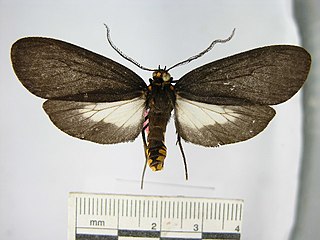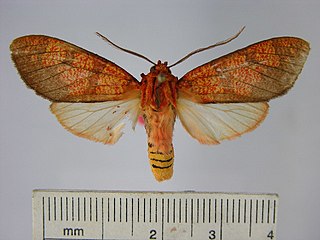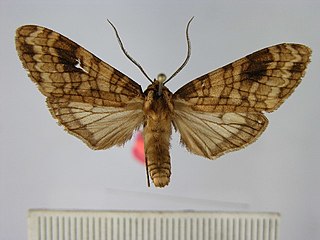"Against Timocrates" was a speech given by Demosthenes in Athens in which he accused Timocrates of proposing an illegal decree. The speech provides our best evidence about the use of imprisonment as a punishment in Classical Athens.
Titan is a fictional location appearing in American comic books published by Marvel Comics. It is depicted in the Marvel Universe as the home of the Titanian Eternals on Saturn's moon Titan. It first appeared in Iron Man #55 and was conceived by Jim Starlin and Mike Friedrich. The Titanians, also known as Titans, were later retconned as being an offshoot of the Eternals, which had been created separately by Jack Kirby.
Elysius is a fictional character appearing in American comic books published by Marvel Comics.
Elysius is a genus of moths in the family Erebidae. The genus was erected by Francis Walker in 1855.
The graphē paranómōn, was a form of legal action believed to have been introduced at Athens under the democracy somewhere around the year 415 BC; it has been seen as a replacement for ostracism which fell into disuse around the same time, although this view is not held by David Whitehead, who points out that the graphe paranomon was a legal procedure with legal ramifications, including shame, and the convicted had officially committed a crime, whereas the ostrakismos was not shameful in the least.

Elysius castanea is a moth of the family Erebidae first described by Walter Rothschild in 1909. It is found in Peru.
Elysius carbonarius is a moth of the family Erebidae. It was described by Paul Dognin in 1891. It is found in Bolivia and Peru.

Elysius chimaera is a moth of the family Erebidae. It was described by Herbert Druce in 1893. It is found in southern Brazil and Paraguay.

Elysius conjunctus is a moth of the family Erebidae. It was described by Walter Rothschild in 1910. It is found in Brazil and Venezuela.

Elysius conspersus is a moth of the family Erebidae. It was described by Francis Walker in 1855. It is found in Panama, Colombia, Venezuela, Peru, Brazil, Paraguay and Ecuador.
Elysius deceptura is a moth of the family Erebidae. It was described by Herbert Druce in 1905. It is found in Peru.

Elysius melanoplaga is a moth of the family Erebidae first described by George Hampson in 1901. It is found in Ecuador and Bolivia.
Elysius intensa is a moth of the family Erebidae. It was described by Walter Rothschild in 1935. It is found in São Paulo, Brazil.
Elysius discopunctata is a moth of the family Erebidae. It was described by Max Gaede in 1923. It is found in Brazil.
Elysius jonesi is a moth of the family Erebidae. It was described by Walter Rothschild in 1910. It is found in Brazil.
Elysius meridionalis is a moth of the family Erebidae. It was described by Walter Rothschild in 1917. It is found in Brazil.
Elysius proba is a moth of the family Erebidae. Described by William Schaus in 1892, it is found in Mexico and Honduras.
Elysius ruffin is a moth of the family Erebidae. It was described by William Schaus in 1924. It is found in French Guiana, Brazil, Venezuela, Ecuador and Peru.
Elysius superba is a moth of the family Erebidae. It was described by Herbert Druce in 1884. It is found in Mexico, Costa Rica and Panama.
Elysius melaleuca is a moth of the family Erebidae. It was described by Felder and Rogenhofer in 1874. It is found in Colombia.



